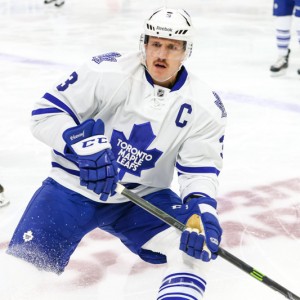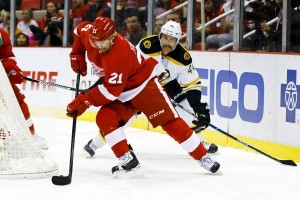The growing divide between traditional statistics and the NHL’s new venture into advanced statistics has many debating over which evaluation technique truly helps recognize the league’s top players. Many teams have poured resources into gaining the upper hand in advanced statistics, which has fuelled the debate over which method can accurately predict success or failure. The Toronto Maple Leafs, who last made the playoffs in 2013, did so largely on the backs of unsustainably high shooting percentages and a playing style predicated on allowing the other team to dominate possession of the puck.
Quite predictably, they fell back to earth in the two seasons after, bottoming out and turning around their franchise with multiple high draft picks and an influx of advanced statistics. The Maple Leafs aren’t the only recent case of teams and players whose advanced statistics lagged noticeably behind their surface performance, resulting in decreased results in the following seasons.

The Maple Leafs aren’t the only recent case of teams and players whose advanced statistics lagged noticeably behind their surface performance, resulting in decreased results in the following seasons. The Colorado Avalanche, led by young star Nathan Mackinnon and a ragtag group of journeymen defensemen, were one of the league’s top teams in 2014, but have failed to crack the playoffs since. The Calgary Flames finished in 25th place last season after making a run to the second round of the playoffs the year before, thanks in no small part to their mediocre goaltending duo turning into a bit of an adventure.
The teams consistently near the top of the standings seem to consistently be successful in these advanced statistics. The Los Angeles Kings, who have won two Stanley Cup championships since 2012, have led the NHL in Corsi for percentage (CF%) in each of the last four seasons. The Pittsburgh Penguins, last year’s Cup champs, finished in the league’s top five for both CF% and goals for percentage (GF%). These teams are anchored by some of the league’s best players in the eyes of advanced statistics, and it’s becoming increasingly apparent that certain players are among a new wave of stars who are far more valuable to their teams than immediately meets the eyes with traditional statistics. These players are some of the best league-wide according to their impact on advanced statistics, but they aren’t always given the recognition they deserve.
Hampus Lindholm, LHD, Anaheim Ducks
One of the league’s many up-and-coming star defenders, Lindholm is the best defender on the contending Ducks and one of the best shutdown blueliners in the NHL. Upon first glance, Lindholm’s third full season in the NHL was marked by inconsistency. Along with the rest of his struggling teammates, Lindholm struggled to produce points in the first half of the 2015-16 season, notching only eight points in his first 35 games. Though he was able to pick up the pace as the Ducks were one of the league’s hottest teams down the stretch, Lindholm still ended up with a career-low 28 points.
With a closer look, Lindholm’s season was more than a down season for him and arguably one of the best of his career. The young Swede emerged as Anaheim’s top blueliner at even strength and one of the league’s best puck possession players. Lindholm finished third among all qualified defenders with an astounding 57.8 Corsi-for mark, trailing just Los Angeles Kings possession stalwarts Drew Doughty and Brayden McNabb in producing shot attempts for his team. Despite his career-low in points, Lindholm also proved he could consistently drive play, placing 12th among all defenders with a 6.4 Corsi-for mark relative to his teammates (CF/60 RelTm). His defensive prowess placed him 14th in the league in goals-against per 60 minutes (GA60) and ninth in goals-against relative to his teammates.
Beyond his elite possession statistics, Lindholm’s understated effect on his teammates was a huge reason for Anaheim’s in-season turnaround last year. Josh Manson, Lindholm’s most frequent partner at even strength, was able to tally a 60.5 corsi% while on the ice with Lindholm, compared to a 52.5% mark without him. It wasn’t just Manson either, as Ducks stars Corey Perry and Ryan Getzlaf saw their possession numbers (in Corsi%) make a significant jump while playing with Lindholm. By season’s end, Lindholm found himself atop the NHL leaderboard in Corsi-for percentage relative to his team (CF%RelTm), proving his importance to the Ducks’ defensive group.
Tyler Toffoli, RW, Los Angeles Kings

Thanks to a suffocating defense-first system implemented by head coach Darryl Sutter, the Los Angeles Kings have become the NHL’s shining example of a dominating possession team. Doughty and fellow defenseman Jake Muzzin are consistently near the top of the league in Corsi-for categories, and young blueliner McNabb saw his underlying numbers skyrocket playing alongside Doughty, the current Norris Trophy winner.
Last year, the NHL’s top six possession players (by Corsi-for%) all called Los Angeles home. While seeing perennial Selke Trophy candidate Anze Kopitar and former 30-goal man Milan Lucic near the top of that list isn’t surprising, the Kings player with the best mark in that category was actually winger Tyler Toffoli.
Just 24 years old, Toffoli solidified himself as a legitimate top line player last season with 31 goals and 58 points, leading the Kings in goals and finishing third in points. However, while most of the NHL is just starting to take notice of the Scarborough- native, Toffoli’s impact on the Kings and his ability to drive the play are already scraping elite levels. Not only did Toffoli lead the Kings in Corsi-for percentage, his 59.4% Corsi-for mark was good enough to lead all forwards in the league. Despite logging the 10th-highest average ice time mark on the team, Toffoli was able to post the fourth-best goals for percentage (GF%) among all forwards. While the Kings are one of the league’s strongest teams and annual analytics darlings, Toffoli was able to distinguish himself by tallying a club-high 15.7 goals for percentage relative to his team (GF% RelTm), showcasing his strong two-way play and scoring abilities.
Not only did Toffoli lead the Kings in Corsi-for percentage, his 59.4% Corsi-for mark was good enough to lead all forwards in the league. Despite logging 10th in average ice time on the team, Toffoli was able to post the fourth-best goals for percentage (GF%) among all forwards. And while the Kings are one of the league’s strongest teams and annual analytics darlings, Toffoli was able to distinguish himself by tallying a club-high 15.7 goals for percentage relative to his team (GF% RelTm), showcasing his strong two-way play and scoring abilities.
At even strength, Toffoli received the most minutes of his young career and surpassed all expectations. Playing mainly alongside Jeff Carter, Toffoli led the league with a Corsi-for per 60 (CF60) mark of 70.8, which places him firmly amongst the league’s best in generating shot attempts and driving possession. Toffoli was rewarded for his well-rounded game, finishing with a league-leading +35 plus/minus rating and increased responsibility on special teams. While bigger names like Kopitar and Doughty (deservedly so) get much of the credit for Los Angeles’ continued success, Toffoli, an emerging star in his own right, deserves to be mentioned as one of the league’s most underrated players.
Toffoli was rewarded for his well-rounded game, finishing with a league-leading +35 plus/minus rating and increased responsibility on special teams. While bigger names like Kopitar and Doughty (deservedly so) get much of the credit for Los Angeles’ continued success, Toffoli, an emerging star in his own right, deserves to be mentioned as one of the league’s most underrated players.
Tomas Tatar, LW, Detroit Red Wings

With the retirement of franchise mainstay Pavel Datsyuk, the Detroit Red Wings’ roster is in a state of flux. Captain Henrik Zetterberg remains one of the only players from Detroit’s last Cup win, but the bulk of their roster consists of recent draft picks and upcoming players. Slovakian
Slovakian winger Tomas Tatar is part of a new wave of Red Wings talent and the 25-year-old sniper has rounded out his game in recent seasons and appears primed to help lead the Red Wings to success after Detroit’s ageing stars have retired. In the five seasons prior coach Mike Babcock’s departure as a free agent, the Red Wings enjoyed four top-five finishes in Team Corsi-for (CF%). However, new coach Jeff Blashill wasn’t able to replicate his predecessor’s success and the Red Wings slumped their way to mediocre possession numbers.
Tatar, another draft steal by the Red Wings’ scouting staff, broke out in 2014-15 with 29 goals and 56 points, cementing himself as a big part of Detroit’s future. In addition to nearly cracking the 30-goal barrier, Tatar emerged as an elite driver of the play, evidenced by his fifth-best 59.0% Corsi-for percentage. His marks for Corsi against per 60 minutes (CA60) and Corsi-for relative to his team (CF% RelTm) both ranked inside top 10 in the league, showing that his numbers weren’t just a product of Babcock’s possession system and highlighted his strong defensive effort.
Under Blashill, 2015-16 wasn’t quite so kind to Tatar, with his numbers dipping to 21 goals and under 50 points. His production per 60 minutes took a hit as well, falling to 138th in goals-for per 60 minutes. Blashill moved Tatar up and down the lineup throughout the year, resulting in a rotating cast of linemates and an obvious dip in possession numbers. Tatar still ranked 21st in Corsi-for% and 21st in Corsi% relative to his team, proving himself as one of the team’s best possession players despite being buried in the lineup at some points during the season.
Thanks to Detroit’s notoriety for over-ripening young players, Tatar is entering just his fourth full season in the league. The Jeff Blashill era didn’t get off to a great start as the team limped into the playoffs before getting manhandled by Tampa Bay in the first round, but they hauled in a couple of big-name free agents during the off-season and look poised to compete for a playoff spot once again. Tatar, just one year removed from a 29 goal season, should get a long look at a permanent spot on one of Detroit’s top two lines. His ability to drive play for the Red Wings is invaluable, and his consistent two-way play could see him return to his production levels of 2014-15 if he can adjust to his new coach’s system.
Tatar, just one year removed from a 29 goal season, should get a long look in a spot on one of Detroit’s top two lines. His ability to drive play for the Red Wings is invaluable, and his consistent two-way play could see him return to his production levels of 2014-15, if he can adjust to his new coach’s system.
All stats taken from Puckalytics.com